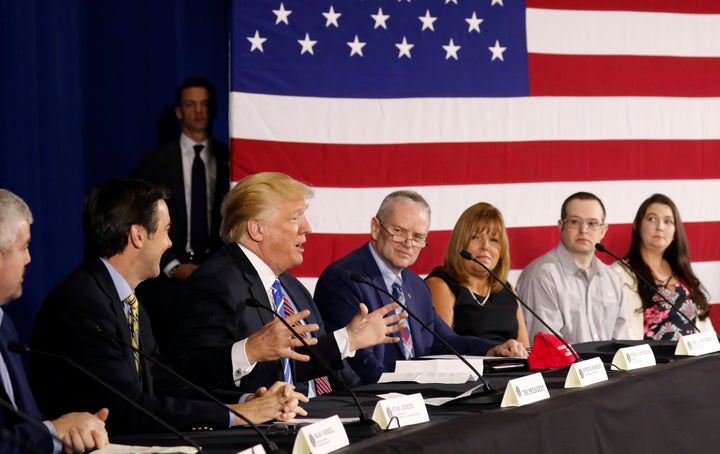
WASHINGTON – President Donald Trump hit the road Thursday to once again tout benefits of the tax cuts he signed into law late last year ― even as most Americans continue to believe there aren’t any.
“Your taxes went down. They went down a lot,” Trump told a handpicked crowd of supporters in White Sulphur Springs, West Virginia. “It’s a lot of money for a lot of people.”
Unfortunately for congressional Republicans facing re-election this November, the majority of workers are still not buying that story, a full two months after they were supposed to see increases in their paychecks.
A recent HuffPost/YouGov poll found that only 25 percent of respondents have seen increases in their after-tax paychecks. More than twice that many ― 60 percent ― said they had not.
Those results mirror numbers from a CNBC poll released a week earlier in March, which found that 32 percent of employees noticed an increase in their take-home pay, compared to 52 percent who had not. And of that 32 percent, just over one-third said the extra pay helped them “a great deal” or a “fair amount.”
Trump, nevertheless, has worked with House and Senate Republican leaders to pitch the tax cuts ― the only significant piece of legislation to pass in his presidency’s first year ― as the foundation of their midterm campaign strategy. Trump has already this year traveled to Pennsylvania, Missouri and Ohio to highlight the tax cuts.
On stage with him Thursday were local company leaders who have given employees pay raises or bonuses, as well as some families who have benefited from the tax cuts.
“I can tell you our people know that your tax cuts have made a difference,” said Terry Dotson, CEO of the truck dealership Worldwide Equipment. “I can tell you that it’s not crumbs to them when they can pay their car payments and invest in their children’s future.”
“Crumbs” referred to the criticism by House Minority Leader Nancy Pelosi (D-Calif.) that the tax plan would disproportionately benefit the wealthiest and that middle- and lower-income taxpayers would receive little.
“This was much more than just crumbs,” echoed Hugh Hitchcock, president of the Davis Trust community bank in nearby Elkins.
But an analysis by the nonpartisan Tax Policy Center of the tax cuts’ effects on actual families shows that middle- and lower-income taxpayers are, in fact, getting a smaller benefit than high-income taxpayers ― both in terms of a percentage reduction as well as in total dollars.
The poorest fifth of taxpayers, those making about $25,000 a year and less, are getting on average a $40 tax cut for the year, according to the analysis, or 0.3 percent of after-tax income. The middle fifth are receiving $780 per year ― about $16 per week – or 1.4 percent of their income. That group’s income ranges from $49,000 a year to $86,000.
But those with incomes ranging from $308,000 to $733,000 a year will benefit the most, with an average tax cut of $11,200, or 3.4 percent of their after-tax income, the analysis found.
Neil Newhouse of Public Opinion Strategies, the Republican-leaning firm that co-conducted CNBC’s poll, acknowledged that his party is having a tough time making the tax-cut message resonate with voters.
“I’m not sure wage-earners knew when to look for the increase in their paychecks or had an idea how much the increase was going to be,” Newhouse said “Keep in mind, $1,000 in additional pay per year would break down to just $38.46 per paycheck ― assuming people get paid every two weeks.”
Peter Hart, the Democratic pollster who worked with Newhouse on that survey, said one factor might be that Republicans have been hobbled by the inability of their party leader to stick to a consistent message.
“Donald Trump is a ‘whack-a-mole’ president. He is constantly taking his bully pulpit and smashing some new target,” Hart said, contrasting him with former President Ronald Reagan, whose 1981 tax cuts have served as model legislation for Republicans ever since. “Unlike Reagan, (when) themes were reinforced week-in-and-week out, there is no theme. Only chaos.”
Indeed, after his opening remarks in White Sulphur Springs on taxes, Trump ranged far and wide in his comments. He literally threw away his prepared speech, saying it “would have been a little boring,” and went off-message.
